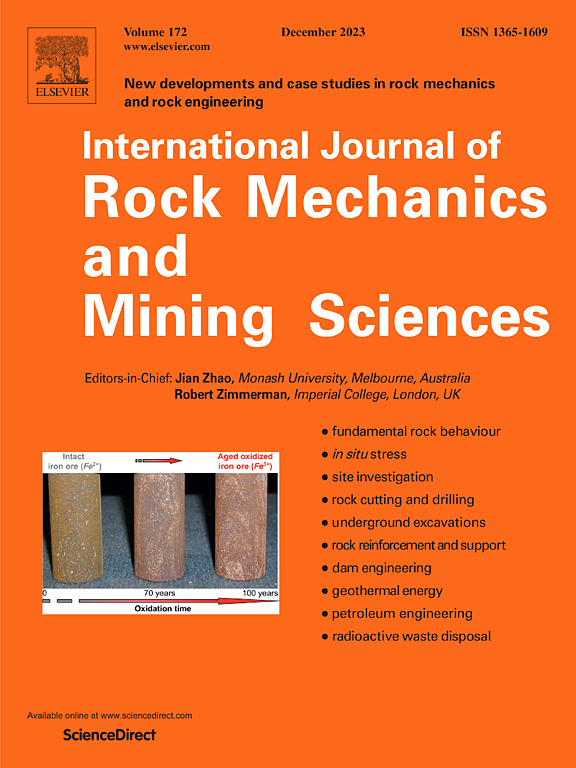基于全尺寸切削试验的TBM刀具与辅助切刀相互作用研究
IF 7
1区 工程技术
Q1 ENGINEERING, GEOLOGICAL
International Journal of Rock Mechanics and Mining Sciences
Pub Date : 2025-04-18
DOI:10.1016/j.ijrmms.2025.106120
引用次数: 0
摘要
当隧道掘进机开挖完整的高强度岩体时,在隧道掘进机掘进工作面上制造切口是提高掘进机掘进效率的一种很有前途的解决方案。切刀可以安排在切刀之间或沿着切刀。沿切口切割的破岩机理尚未完全揭示,需要对两种布置的切割性能进行量化比较。通过直线切割试验,研究了沿切口切割的破岩方式和破岩效率。设计了不同的切口深度(D)和刀具穿透度(P)组合。分析了切削力、振动、渣土特性和破岩比能。结果表明,沿切口切割存在两种不同的模式。P = 2 mm或D = 2倍P时出现开槽模式,开槽有利于形成较厚的破碎带,同时约束了横向裂缝的扩展,开槽扩大为开槽,产生较多的岩粉,切割力和振动较不开槽时明显减小。当D不大于P时,出现了切屑模式,宏观裂纹经过多层切割积累并延伸到相邻的切缝底部,产生较大的岩石切屑,虽然切削力和振动高于开槽模式,但比能明显低于开槽模式。比较了另一项研究中沿切口切割与切口间切割的性能参数。在切缝模式下,岩层的切削效率低于切缝模式下的切削效率,而切槽模式下的切削力和振动明显较低。在此基础上,结合两种切削方式的优点,提出了一种用于切口辅助切削的刀盘设计概念。该研究有助于新一代切口辅助tbm的开发。本文章由计算机程序翻译,如有差异,请以英文原文为准。
Study on interaction between TBM cutter and assisting kerfs based on full-scale cutting tests
When tunnel boring machines (TBMs) excavate intact high-strength rock masses, creating kerfs on the tunnel face is a promising solution to enhance the efficiency of TBM cutters. The cutters can be arranged to cut between kerfs or cut along kerfs. The rock breaking mechanism of cutting along kerfs is not fully revealed yet, and a quantified comparison in cutting performance between the two arrangements is needed. This study investigated the rock breaking mode and efficiency of cutting along kerfs by linear cutting tests. Different combinations of kerf depth (D) and cutter penetration (P) were designed. Cutter force, vibration, muck characteristics and rock breaking specific energy were analyzed. The results revealed two distinct modes existed in cutting along kerfs. Grooving mode occurred when P was 2 mm or when D was twice P, the kerf facilitated the formation of a thick crushed zone while constrained the expansion of lateral cracks, the kerfs were enlarged into grooves, producing much rock powder, the cutter force and vibration were significantly reduced compared to cutting without kerfs. Chipping mode occurred when D was not greater than P, macro cracks accumulated and extended to the bottom of the adjacent kerf after multiple layers of cuts, producing large rock chips, although the cutter force and vibration were higher than those of the grooving mode, the specific energy was significantly lower. The performance parameters of cutting along kerfs were compared with those of cutting between kerfs from another research. The rock formation in the chipping mode was less efficient than cutting between kerfs, while the cutter force and vibration in the grooving mode were significantly lower. Consequently, a conceptual cutterhead design for kerf-assisted cutting was proposed, which combined the advantages of the two cutting arrangements. The study contributes to the development of a new generation of kerf-assisted TBMs.
求助全文
通过发布文献求助,成功后即可免费获取论文全文。
去求助
来源期刊
CiteScore
14.00
自引率
5.60%
发文量
196
审稿时长
18 weeks
期刊介绍:
The International Journal of Rock Mechanics and Mining Sciences focuses on original research, new developments, site measurements, and case studies within the fields of rock mechanics and rock engineering. Serving as an international platform, it showcases high-quality papers addressing rock mechanics and the application of its principles and techniques in mining and civil engineering projects situated on or within rock masses. These projects encompass a wide range, including slopes, open-pit mines, quarries, shafts, tunnels, caverns, underground mines, metro systems, dams, hydro-electric stations, geothermal energy, petroleum engineering, and radioactive waste disposal. The journal welcomes submissions on various topics, with particular interest in theoretical advancements, analytical and numerical methods, rock testing, site investigation, and case studies.

 求助内容:
求助内容: 应助结果提醒方式:
应助结果提醒方式:


